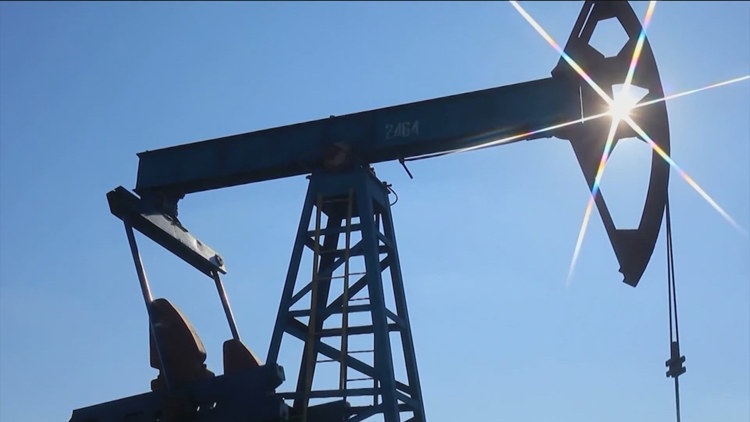TEXAS, USA — This article was originally published by our content partners at the Texas Tribune. Read the original article here.
Unable to keep up with the growing number of leaking and erupting wells in the state’s oil fields, the Texas Railroad Commission, which regulates the state’s oil and gas industry, has asked lawmakers for an additional $100 million in emergency funding — which would be equal to about 44% of the agency’s entire two-year budget.
Danny Sorrell, the agency’s executive director, sent the letter two months after the commission filed its annual budget request in August, according to the Houston Chronicle. He said the agency’s $226 million budget request did not include enough money “to protect the groundwater and the environment” from increasingly common well blowouts.
The agency follows a rating system to determine which wells it needs to plug first, according to Texas law. Priority 1 wells are leaking wells that pose environmental, safety, or economic risks. An uncontrolled flow of water occurring at a well constitutes an emergency, said R.J. DeSilva, a spokesperson for the agency. In an emergency, agency staff “respond immediately to plug it,” he said.
The agency said that it addresses actively leaking wells regardless of whether it has enough money in the designated budget for well remediation, a practice that Sorrell said has become unsustainable and caused the agency to plug fewer non-emergency wells each year.
“These high-priority wells need to be taken care of before they themselves become emergency wells,” he said.
There are approximately 140,000 so-called orphaned wells in the U.S. and more than 9,000 of them are in Texas, according to the Interstate Oil and Gas Compact Commission. These are abandoned wells that have been inactive for at least 12 months and have no clear ownership.
When left unattended, orphaned wells are prone to blowouts that spew contaminated water onto the surrounding land. Experts said the routine industry practice of injecting fracking wastewater — called produced water — into underground rock formations, contributes to the problem.
At least eight wells have leaked and burst since last October, Sarah Stogner, an oil and gas attorney, told the Texas Tribune earlier this month. Stogner has tracked such wells for years.
In December 2023, an abandoned well that blew out in Imperial, southwest of Odessa, took more than two months to plug. That well alone cost regulators $2.5 million to cap and clean up.
In October, another well in Toyah burst and released a torrent of water that took weeks to contain. Kinder Morgan, the energy firm that assumed responsibility for the well, did not say how much it cost to seal.
The briney water is laden with chemicals it collects underground, including hydrogen sulfide, a toxic and deadly gas.
Congress approved $4.7 billion to plug orphan wells on public and private lands as part of the Bipartisan Infrastructure Law passed in 2021. Texas received $25 million of that money in 2022 and another $80 million in January.
The Railroad Commission used that money to plug 737 wells — 10% of the estimated orphaned wells in Texas. It also plugged 1,754 wells through an initiative funded by $63 million in state money.
The efforts have not been enough.
Sorrell’s letter to Lieutenant Gov. Dan Patrick and House Speaker Dade Phelan said that regulators need the money to staff a team of inspectors who can investigate the cause of the blowouts, which they associate with produced water injections. Sorrells said the agency's ability “to assess, characterize and evaluate these events is limited by the currently available resources.”
Sorrells said the cost to plug wells, which includes labor and materials like cement and rigs, has increased by 36% since 2022.
Both oil and gas industry leaders and environmental advocates in Texas applauded the commission’s request.
“We have long supported increases in funding for the Commission in this and other areas,” said Ben Sheppard, president of the Permian Basin Petroleum Association. “We would support the Legislature going above and beyond the Commission’s request for plugging and remediation funding. The industry generates billions of dollars every year, and it seems appropriate that more of these dollars could be utilized for this important purpose.”
Julie Range, a policy manager for Commission Shift, an oil and gas watchdog group, commended the agency’s request.
“We hope the investigation team will prompt the Railroad Commission to scrutinize their approval process and deny more injection wells that pressurize underground aquifers and cause many of these wells to reach emergency status,” she said.
For years, a growing chorus of experts and ranchers have warned the commission about the rising threat the wells pose to the environment and the region’s vulnerable groundwater resources.
In August, researchers at Southern Methodist University found a link between the common practice of injecting wastewater from fracking underground and the blowouts occurring across the oil-rich Permian Basin — a 75,000-square-mile region straddling West Texas and New Mexico.
More Texas headlines:



